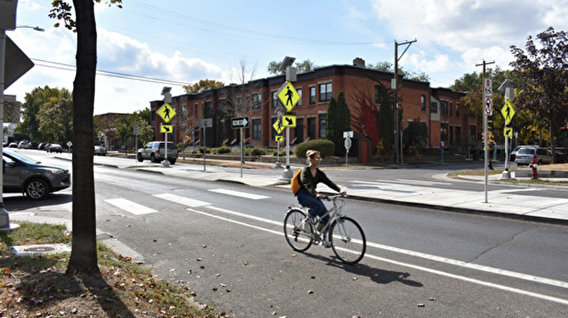For many Minnesota communities, a road diet could help improve both safety and the user experience—but knowing when it’s a good fit can be challenging. A recent project developed a better understanding of road conversions and their impact on motor vehicle capacity at different traffic volumes, using 15,000 as a key threshold.

The term “road diet”—also known as a 4-3 conversion—describes the process of converting a four-lane road to three lanes; the converted road has two travel lanes separated by a two-way turning lane. Often, a road diet can significantly reduce crashes while making space for other infrastructure such as bikeways or transit lanes at a relatively low cost. However, little guidance exists regarding the traffic volumes at which a conversion would result in an unacceptable decrease in the level of service (LOS) for drivers.
For the project, sponsored by the Minnesota Local Road Research Board, three roads in Minnesota were selected for a simulation study of 4-3 conversion impacts. The locations had traffic volumes between 10,000 and 25,000 vehicles per day and a variety of intersection configurations.
Using traffic simulations, researchers computed average motor vehicle delays at intersections and average motor vehicle speed in the corridors. The simulation results were summarized in tables showing LOS ratings. Then, eight intersection configurations were selected to represent the study’s results and serve as example intersections for acceptable and unacceptable LOS changes at various traffic volumes.
“While a detailed evaluation of design elements should precede a 4-3 road conversion, the guidance tables will allow engineers to make an initial assessment of the potential impacts to level of service,” says Gary Davis, a professor with the U of M’s Department of Civil, Environmental and Geo- Engineering and the lead investigator.
Through this study, researchers learned that guidelines based solely on average daily traffic (ADT) can be misleading. Traffic volumes must be considered in tandem with motor vehicle demand on the crossroads, hourly volumes, and other factors. “Generally, we found that 4-3 conversions can be feasible for ADTs greater than 15,000 as long as demands on crossroads remain low enough,” Davis says.
—Megan Tsai, contributing writer
Learn more:
- Criteria and Guidelines for Three-Lane Road Design and Operation (LRRB/MnDOT, 2023)
- Plymouth to put Vicksburg Lane on a road diet to curb speeding, crashes (Star Tribune, Sept. 24, 2023)